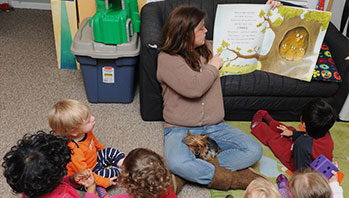- city
- country
- creaking
- loud
- nighttime
- soft
- sound
- tractor
MA Standards:
Literature/RL.PK.MA.1: With prompting and support, ask and answer questions about a story or a poem read aloud.
Literature/RL.PK.MA.6: With prompting and support, “read” the illustrations in a picture book by describing a character or place depicted, or by telling how a sequence of events unfolds.
Literature/RL.PK.MA.4: With prompting and support, ask and answer questions about unfamiliar words in a story or poem read aloud.
Head Start Outcomes:
Language Development/Receptive Language: Attends to language during conversations, songs, stories, or other learning experiences.
Literacy Knowledge/Book Appreciation and Knowledge: Asks and answers questions and makes comments about print materials.
PreK Learning Guidelines:
English Language Arts/Reading and Literature 6: Listen to a wide variety of age appropriate literature read aloud.
Read Together: Night in the Country #1

© Commonwealth of Massachusetts, Department of Early Education and Care (Jennifer Waddell photographer). All rights reserved.
STEM Key Concepts: Sounds have a source; An action has to happen to make a sound; Different objects make different sounds
ELA Focus Skills: Concepts of Print, Speaking and Listening, Story Comprehension, Vocabulary
Before You Read
Hold up the Night in the Country by Cynthia Rylant and ask children to describe what they see on the cover.
- Point to the setting sun and ask, How does this picture help you know what time of day it is in the story? (when the sun goes down it is nighttime)
- Ask children if they have ever been to the country and discuss the sounds and the things you hear and see in the country. Say, Can you tell me some things you might see in the country? Do the same for the city.
- Then hold up the book and ask, Where do you think this story takes place, in the country or in the city? Why do you think so?
Set a listening focus for children by asking them to imagine the nighttime sounds in the story. Have them think about whether or not they hear these sounds at night.
As You Read
You may want to darken the room to set the mood while reading. Read the story slowly in a soft, soothing tone.
- Point to and identify the illustration of the red tractor on the title page. Ask children if they think a tractor makes a loud or a soft sound? Why do you think so?
- Point to and identify animals in the story. As you point, have children think about the sound each animal makes. Ask, Do you think it makes a loud or soft sound? Can you make the sound?
- Vary the volume of your voice as you add loud and soft sound effects to demonstrate the meaning of sound words in the story such as, clinks, creaking, groan, thump, and squeaks.
After You Read
Display the "Nighttime Sounds" chart. Talk about the story with children. Ask questions such as,
- Did you hear any of the same sounds at night where you live that are in the story? Read a few entries if needed.
- Which sounds are country sounds? Which ones are city sounds?
- Do you think the city or the country has more loud sounds? Which has more soft sounds? Why do you think so?
Educator Tip: You may want to do a second read on another day and act out the meaning of action words such asswoop, patter, and nuzzles.
Math Tip: As children describe the nighttime sounds heard in the country and the nighttime sounds they hear where they live, record their answers in a Venn diagram. Explain what each part of the diagram means. Say, These are the nighttime sounds heard in the country; these are the nighttime sounds heard where we live; these are the nighttime sounds heard in both places (point to place where ovals overlap).
